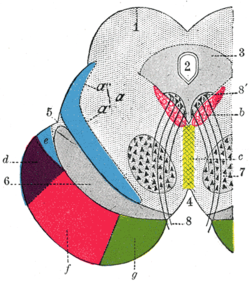- Medial longitudinal fasciculus
-
Brain: Medial longitudinal fasciculus 
Transverse section of mid-brain at level of inferior colliculi. (Medial longitudinal fasciculus labeled at center right.) 
Axial section through mid-brain.
1. Corpora quadrigemina.
2. Cerebral aqueduct.
3. Central gray stratum.
4. Interpeduncular space.
5. Sulcus lateralis.
6. Substantia nigra.
7. Red nucleus of tegmentum.
8. Oculomotor nerve, with 8’, its nucleus of origin. a. Lemniscus (in blue) with a’ the medial lemniscus and a" the lateral lemniscus. b. Medial longitudinal fasciculus. c. Raphé. d. Temporopontine fibers. e. Portion of medial lemniscus, which runs to the lentiform nucleus and insula. f. Cerebrospinal fibers. g. Frontopontine fibers.Latin fasciculus longitudinalis medialis Gray's subject #188 803 NeuroNames ancil-743 The medial longitudinal fasciculus (MLF) is a pair of crossed fiber tracts (group of axons), one on each side of the brainstem. These bundles of axons are situated near the midline of the brainstem and are composed of both ascending and descending fibers that arise from a number of sources and terminate in different areas.
Contents
Function
The MLF carries information about the direction that the eyes should move.
It yokes the cranial nerve nuclei III (Oculomotor nerve), IV (Trochlear nerve) and VI (Abducens nerve) together, and integrates movements directed by the gaze centers (frontal eye field) and information about head movement (from cranial nerve VIII, Vestibulocochlear nerve). It is an integral component of saccadic eye movements as well as vestibulo-ocular and optokinetic reflexes.
It also carries the descending tectospinal tract and medial vestibulospinal tracts into the cervical spinal cord, and innervates some muscles of the neck and upper limbs.
Inputs
The descending MLF mainly arises from the medial Vestibular nucleus (VN) and is thought to be involved in the maintenance of gaze. This is achieved by inputs to the VN from
- the Vestibulocochlear (8th cranial) nerve about head movements,
- gain adjustments from the flocculus of the cerebellum,
- head and neck propioceptors and foot and ankle muscle spindle, via the fastigial nucleus.
Descending fibers can also arise from the superior colliculus in the rostral midbrain for visual reflexes, the accessory occulomotor nuclei in the rostral midbrain for visual tracking, and the pontine reticular formation, which facilitates extensor muscle tone. Ascending tracts arise from the Vestibular nucleus (VN) and terminate in the III, IV and VI nuclei, which are important for visual tracking.
Pathology
Lesions of the MLF produce internuclear ophthalmoplegia and can be a presenting symptom of multiple sclerosis,[1] where it presents as nystagmus and occasionally diplopia.[2] These lesions cause damage to the ipsilateral (same side) eye, but nystagmus on the contralateral (opposite side) eye.
History
In 1846 neurologist Benedict Stilling first referred to what is now known as the MLF as the acusticus, followed by Theodor Meynert in 1872 calling it posterior. But in 1891, Heinrich Schutz chose the name dorsal to describe the longitudinal bundle, "for brevity's sake". This name stuck despite other authors attempting further renaming (Ramon y Cajal's periependymal in 1904, Theodor Ziehen's nubecula dorsalis in 1913). But finally, it was Wilhelm His, Sr. who changed the name to medial for the sake of the Basle nomenclature to end the confusion.
Additional images
References
External links
- Medial+longitudinal+fasciculus at eMedicine Dictionary
- Atlas of anatomy at UMich n2a4p4 - "Brainstem, Cranial Nerve Nuclei, Sagittal Section, Medial View"
- http://isc.temple.edu/neuroanatomy/lab/atlas/papc/
Human brain: rhombencephalon, myelencephalon: medulla (TA A14.1.04, GA 9.767) Dorsal SurfacePosterior median sulcus · Posterolateral sulcus · Area postrema · Vagal trigone · Hypoglossal trigone · Medial eminenceafferent: GVA: VII,IX,X: Solitary/tract/Dorsal respiratory group · SVA: Gustatory nucleus · GSA: VIII-v (Lateral, Medial, Inferior)
efferent: GSE: XII · GVE: IX,X,XI: Ambiguus · SVE: X: Dorsal · IX: Inferior salivatory nucleusSensory decussation · Medial lemniscus · Inferior cerebellar peduncle (Juxtarestiform body) · Ascending dorsal longitudinal fasciculus · MLF, III, IV and VIVentral Ventral respiratory group · Arcuate nucleus of medulla · Inferior olivary nucleus · Rostral ventromedial medullaSurfaceGrey: Raphe/
reticularHuman brain, rhombencephalon, metencephalon: pons (TA A14.1.05.101–604, GA 9.785) Dorsal/
(tegmentum)SurfaceTrapezoid body/VIII · Trigeminal lemniscus (Dorsal trigeminal tract, Ventral trigeminal tract) · Medial lemniscus · Lateral lemniscus
MLF, III, IV and VI: Vestibulo-oculomotor fibers
Anterior trigeminothalamic tract · Central tegmental tractICP (Vestibulocerebellar tract)
MLF, III, IV and VI: Vestibulospinal tract (Medial vestibulospinal tract, Lateral vestibulospinal tract)Other greyVentral/
(base)SurfaceBasilar sulcusOther grey: Raphe/
reticularHuman brain: mesencephalon (midbrain) (TA A14.1.06, GA 9.800) Tectum
(Dorsal)SurfacePeduncle
(Ventral)lemnisci (Medial, Lateral) · Ascending MLF (Vestibulo-oculomotor fibers) · Spinothalamic tract · Anterior trigeminothalamic tract · Dentatothalamic tractPeriaqueductal gray/Raphe nuclei (Dorsal raphe nucleus)
Ventral tegmental area • Pedunculopontine nucleus • Red nucleus
riMLFBaseSurfaceSensory system: Visual system and eye movement pathways Visual perception 1° (Bipolar cell of Retina) → 2° (Ganglionic cell) → 3° (Optic nerve → Optic chiasm → Optic tract → LGN of Thalamus) → 4° (Optic radiation → Cuneus and Lingual gyrus of Visual cortex → Blobs → Globs)Muscles of orbit TrackingHorizontal gazeVertical gazePupillary reflex Pupillary dilation1° (Posterior hypothalamus → Ciliospinal center) → 2° (Superior cervical ganglion) → 3° (Sympathetic root of ciliary ganglion → Nasociliary nerve → Long ciliary nerves → Iris dilator muscle)1° (Retina → Optic nerve → Optic chiasm → Optic tract → Visual cortex → Brodmann area 19 → Pretectal area) → 2° (Edinger-Westphal nucleus) → 3° (Short ciliary nerves → Ciliary ganglion → Ciliary muscle)Circadian rhythm M: EYE
anat(g/a/p)/phys/devp/prot
noco/cong/tumr, epon
proc, drug(S1A/1E/1F/1L)
Categories:- Brainstem
- Central nervous system pathways
Wikimedia Foundation. 2010.



